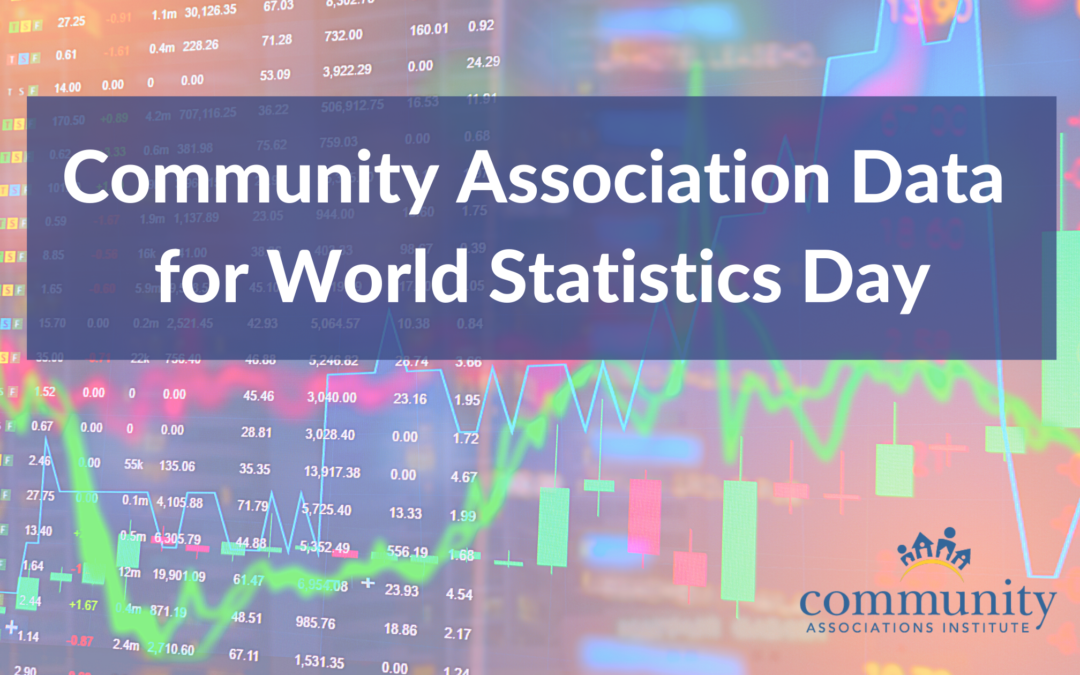Is there a better day than World Statistics Day—celebrated every five years on October 20—to promote community association housing model statistics? The 2020 World Statistics Day’s theme was “Connecting the world with data we can trust—which reflects the importance of trust, authoritative data, innovation, and the public good.
For decades, CAI and the Foundation for Community Association Research worked to compile and publish credible and reliable data and statistics related to the community association housing model. Cliff Treese, CIRMS, president of Association Data Inc., and a past president of CAI and the Foundation, is our primary research statistician. A recognized leader in everything pertaining to common-interest communities, Treese has continuously and tirelessly captured statistics showing the growth of the community association housing model since 1999.
As part of World Statistics Day, we highlight some important community association statistics.
Community Association Manager Compensation
Conducted by the Foundation since 2000, the most recent edition of the salary survey says that managers who obtained the Certified Manager of Community Associations (CMCAÒ) credential earn, on average, 20% more than non-credentialed community association managers.
COVID-19 Impact Surveys
Earlier this year, CAI sent out a series of surveys to measure the impact of the COVID-19 pandemic on community associations. Our employment impact survey found that 91% of community association managers reported no impact to their employment during the pandemic. In addition, a survey fielded to determine financial impacts in the ability of residents to pay assessments found that 90% of homeowners were current in their payments as of August.
Community Association Factbook
The Community Association Factbook supports the Foundation’s mission to provide research-based information to all community association stakeholders—homeowners, board members, management professionals, business partners, as well as housing developers, mortgage lenders, federal agencies, and public officials. Highlights from data collected in 2019 include:
73.9 million – U.S. population living in community associations
351,000 – Number of community associations in the U.S.
$7.19 trillion – Value of homes in community associations
$289 billion – Total economic contributions to community associations in 2019, including volunteer time, real estate taxes, home improvements, and housing services
$96 billion – Assessments collected from homeowners annually
$27.4 billion – Assessments contributed to association reserve funds for the repair, replacement, and enhancement of common property
55,000–60,000 – Community association managers
6,000–9,000 – Large-scale community associations, i.e., those meeting at least two of the following three criteria: a single, contiguous community with a general manager; a minimum of 1,000 lots and/or homes; and a minimum annual budget of $2 million.
30–40% – Share of community associations that are self-managed, meaning they may use professional assistance for specific projects, activities, and services but do not employ a professional manager or management company
77% – Share of new housing built for sale in a community association
8,000–9,000 – Community association management companies
100,000–105,000 – Individuals employed by management companies
2.4 million – Community association board and committee members
2020 Homeowner Satisfaction Survey
This biennial, nationwide survey provides a better understanding of how Americans describe their experience living in common-interest communities. Here are some of the highlights from the 2020 survey:
89% of residents rate their overall community association experience as “very good” or “good” (70%) or “neutral” (19%).
89% say members of their elected governing board “absolutely” or “for the most part” serve the best interests of their communities.
74% say their community managers provide value and support to residents and their associations.
94% say their association’s rules protect and enhance property values (71%) or have a neutral effect (23%); only 4% say rules harm property values.
Visit the Foundation for Community Association Research and CAI to stay up-to-date on valuable data and statistics.



